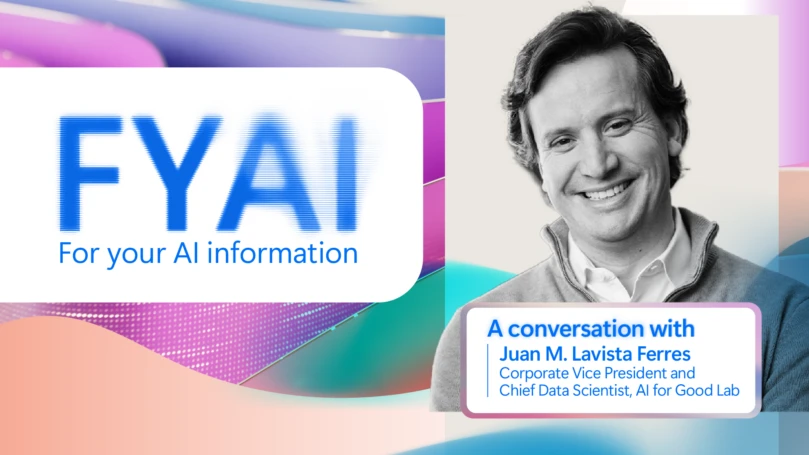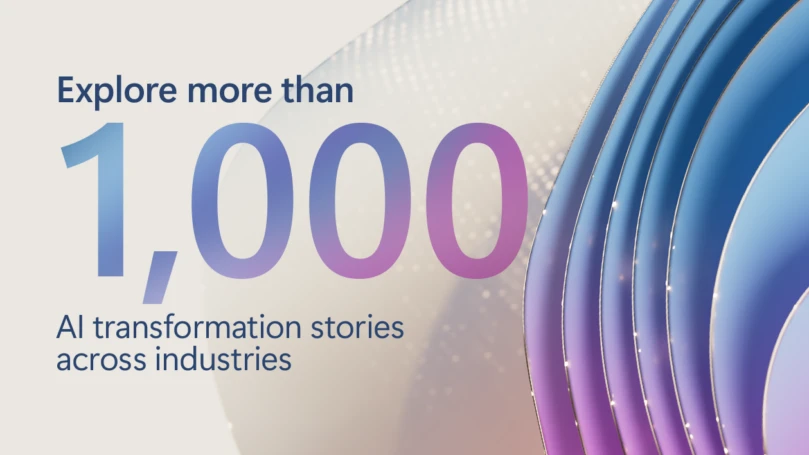Microsoft launched the AI for Good Lab in 2018 to harness the transformative power of AI to tackle global challenges and improve lives. The data scientists and researchers in the AI for Good Lab are experts in their fields from around the world, and their innovative work wouldn’t be possible without a global network of hundreds of organizations who provide critical subject matter expertise for the challenges we are trying to solve.
In this edition of FYAI, a series where we dive deep on AI trends with Microsoft leaders, we hear from Juan M. Lavista Ferres, Corporate Vice President and Chief Data Scientist for Microsoft’s AI for Good Lab, who is leading Microsoft’s efforts to create a collaborative ecosystem and a team of dedicated data scientists and researchers, domain experts, and organizations worldwide that drives progress toward addressing some of the world’s most pressing challenges.
In this Q&A, Juan shares his insights on the growing AI for good movement, how Microsoft partners with local organizations to help solve region-specific challenges, and how to measure and scale AI projects to drive impact.
You’re Microsoft’s Chief Data Scientist and Director of the Microsoft AI for Good Lab. What does that actually look like day-to-day?
My journey at Microsoft started all the way back in 2009 when I was running randomized controlled experiments as part of Microsoft EXP. Looking back, so much of my work then informed what eventually matured into our official AI for Good program. One of our first AI projects focused on better understanding the causes of sudden infant death syndrome. The research we produced with our collaborators helped understand some of the causes—and in so doing, reinforced our conviction that AI can be an indispensable tool in improving people’s lives.
This also illuminated a gap that clearly needed to be filled. The majority of AI expertise in the world is concentrated in the tech and financial sectors, and too many organizations working on solving important societal problems don’t have the resources or technological expertise to apply AI to their work. We help fill this gap by providing AI expertise and compute capacity to bring cutting-edge technology to our partner organizations.
I have a strong bias for action, so each day I am focused on how we can leverage AI to help the most people, as fast as possible. This means I work with our team to conduct applied research, seek out and engage diverse new partners, and guide the build out and deployment of AI solutions. In many ways, this is my dream job. I get to find ways to use data, apply AI, and improve the world, and do so with some of the most gifted researchers and scientists.
Microsoft as customer zero: Empowering research teams with ai
Our Lab was one of the first in the AI for Good space, which I’m proud to say has become a growing movement. The United Nations, for instance, hosts an annual AI for Good conference which we participated in this July in Geneva. It’s no surprise that this is catching on. For many of the problems we’re working on, AI isn’t just a solution, it’s the only solution.
Who is Microsoft partnering with to solve region-specific or community-based challenges?
Partnership is at the heart of the work we do. We believe that in order to make the most of AI’s potential to benefit everyone, we must leverage local, on-the-ground expertise to co-create solutions tailored for the communities with whom we’re working. We have teams in Microsoft offices in the United Arab Emirates, South America, and Kenya because it’s vitally important for us to work alongside local researchers.
One example of the importance of partnership in practice is our work to detect historical flooding and improve disaster response globally. Floods are among the deadliest forms of extreme weather, affecting millions of people and causing over USD40 billion in damage each year. To address this, we developed a model using 10 years of Synthetic Aperture Radar (SAR) data, which can detect floods through clouds, at night, and in remote regions. This is the first model of its kind. We worked closely with partners in Kenya, Ethiopia, Spain, and the United Nations to enable real-time response. In Ethiopia, we used the model to detect nearly three times more flood-prone areas than existing datasets. It confirmed known flood zones and revealed new ones, offering a more complete view of flood risk across the country. After devastating floods struck Kenya in May 2024, we used this tool to estimate that 75,000 hectares—about 2% of all cropland—were flooded or at risk.
In many cases, the value proposition we’re bringing to the table is not only increased accuracy but also speed. If we can use AI to, for example, measure deforestation in the Amazon in a matter of days rather than months, governments in the area can respond much faster.
How do you measure the impact of AI for Good projects?
The definition of ‘impact’ is unique to each project, but overarchingly, we assess whether and to what extent people’s lives have been improved through our work. The key to achieving this is being guided by subject matter experts who have a robust understanding of the challenges to be solved and the data available to solve them. Our goal is always to support our partners and advance their missions, whether that means forecasting malnutrition with greater precision or improving how we track giraffe populations to support conservation efforts.
We also want to expand the benefits of this technology to communities that otherwise might not be able to take advantage of it. For example, we’re working on a tool to diagnose retinopathy of prematurity in low-resource settings where pediatric ophthalmologists aren’t available. Retinopathy of prematurity is an increasingly common condition, thanks to improvements in maternal and infant healthcare that saves the lives of prematurely born babies around the globe. But if this condition isn’t diagnosed and treated, it can lead to lifelong blindness. We’ve developed algorithms that demonstrate how AI can help detect this condition using videos captured on a smartphone. This has the potential to empower healthcare professionals to intervene early in an infant’s life and preserve their eyesight.
The more accurate and useful our AI tools are, the greater their downstream impact will be. This is no small feat. AI technology is evolving and changing rapidly, and our researchers work tirelessly to stay at the forefront.
Where do you see the biggest need—and opportunity—to scale this work?
In order to really scale the benefits of AI, we need to ensure that people are connected not just to AI but to digital technology in general, which is still out of reach for 2.6 billion people around the world.
Our team has invested heavily in developing disaster response capabilities using geospatial machine learning and satellite imagery. We plan to continue supporting first responders in the immediate aftermath of natural disasters in the United States and across the globe. We’ve also seen tremendous benefits of using AI for biodiversity conservation, such as in the Amazon and in Sub-Saharan Africa.
As a non-native English speaker from Uruguay, I use AI to ensure my grammar in documents like research papers is pristine and error-free. A vast majority of academic publications and journals are in English. Large language models have made it easier for myself and countless others to contribute their research, which is a tide that lifts all boats.
What’s a project you’re most excited about right now—and why?
At the end of 2024, we announced Project SPARROW, an AI-powered edge computing solution designed to autonomously collect biodiversity data in the most remote corners of the planet. These devices can run for long periods of time on solar power without disrupting the ecosystems in which they’re embedded, which is one of the aspects of the project I’m most excited about. Protecting vital ecosystems benefits people, animals, and our planet. Our goal is to have SPARROW operating on every continent by the end of the year.
In June 2025, I traveled to Nairobi to connect with our AI for Good Lab in Kenya and our partners on the ground there. I was also invited to give a TED talk focused on SPARROW and the opportunities it presents to increase biodiversity. I highlighted earlier the importance of partnerships with local organizations, and I view this as a chance to uplift our collaboration.
Using AI to make new discoveries and improve people’s lives
When researchers, conservationists, nonprofits, non-governmental organizations (NGOs), and academic institutions are tasked with doing more with less, technology offers a way forward. AI transforms the way we can use data to make new discoveries and improve lives.
Microsoft is investing not only in solving today’s challenges but also paving the way for a brighter tomorrow. Our work helps showcase the potential benefits of AI, pushing the bounds of what was previously possible. By applying advanced AI to real-world datasets, the AI for Good Lab helps unlock insights that empower communities and accelerate progress on urgent global issues.
AI for Good Lab
harness the transformative power of AI to tackle global challenges and improve lives.

Want to learn more? Here are a few resources
- Explore the AI for Good Lab’s projects.
- Begin your AI journey with AI resources and solutions from Microsoft.
- Check out our recently announced AI Economy Institute, Microsoft’s corporate think tank dedicated to advancing independent research and developing actionable solutions that can help societies worldwide positively adapt to the economic and social transformations brought by AI.




